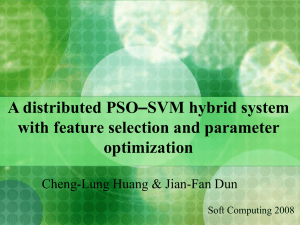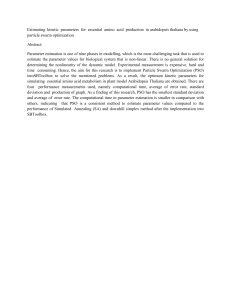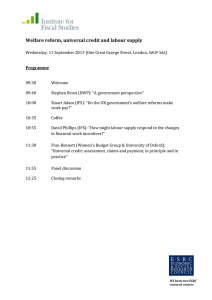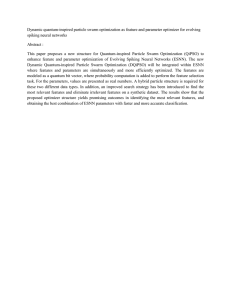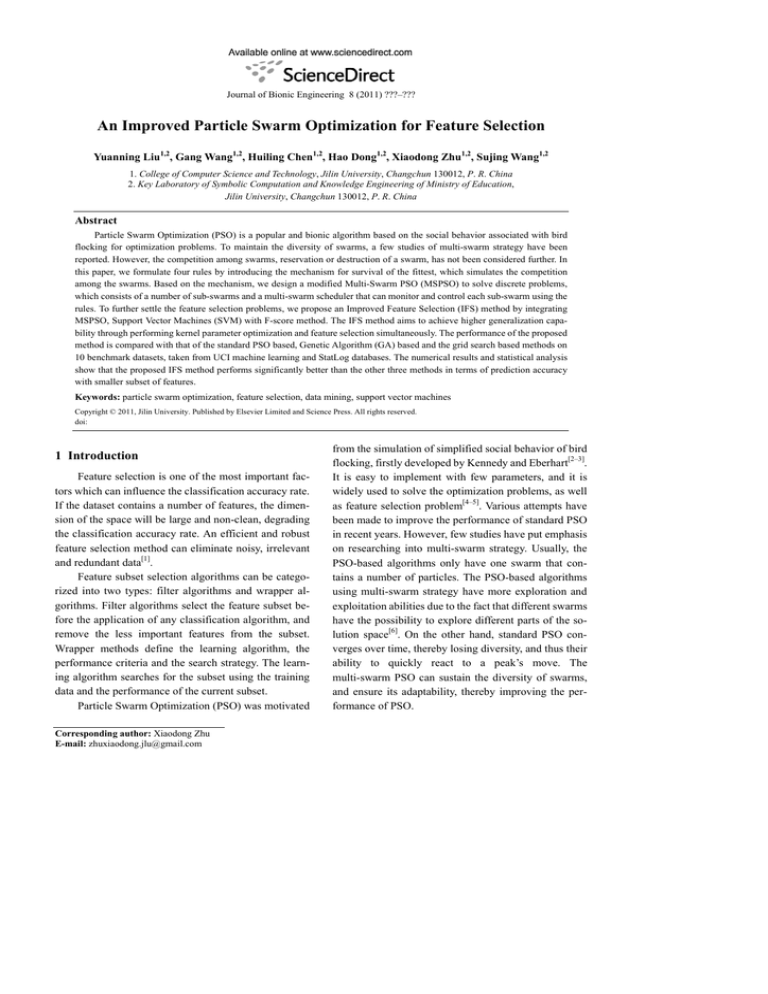
Journal of Bionic Engineering 8 (2011) ???–???
An Improved Particle Swarm Optimization for Feature Selection
Yuanning Liu1,2, Gang Wang1,2, Huiling Chen1,2, Hao Dong1,2, Xiaodong Zhu1,2, Sujing Wang1,2
1. College of Computer Science and Technology, Jilin University, Changchun 130012, P. R. China
2. Key Laboratory of Symbolic Computation and Knowledge Engineering of Ministry of Education,
Jilin University, Changchun 130012, P. R. China
Abstract
Particle Swarm Optimization (PSO) is a popular and bionic algorithm based on the social behavior associated with bird
flocking for optimization problems. To maintain the diversity of swarms, a few studies of multi-swarm strategy have been
reported. However, the competition among swarms, reservation or destruction of a swarm, has not been considered further. In
this paper, we formulate four rules by introducing the mechanism for survival of the fittest, which simulates the competition
among the swarms. Based on the mechanism, we design a modified Multi-Swarm PSO (MSPSO) to solve discrete problems,
which consists of a number of sub-swarms and a multi-swarm scheduler that can monitor and control each sub-swarm using the
rules. To further settle the feature selection problems, we propose an Improved Feature Selection (IFS) method by integrating
MSPSO, Support Vector Machines (SVM) with F-score method. The IFS method aims to achieve higher generalization capability through performing kernel parameter optimization and feature selection simultaneously. The performance of the proposed
method is compared with that of the standard PSO based, Genetic Algorithm (GA) based and the grid search based methods on
10 benchmark datasets, taken from UCI machine learning and StatLog databases. The numerical results and statistical analysis
show that the proposed IFS method performs significantly better than the other three methods in terms of prediction accuracy
with smaller subset of features.
Keywords: particle swarm optimization, feature selection, data mining, support vector machines
Copyright © 2011, Jilin University. Published by Elsevier Limited and Science Press. All rights reserved.
doi:
1 Introduction
Feature selection is one of the most important factors which can influence the classification accuracy rate.
If the dataset contains a number of features, the dimension of the space will be large and non-clean, degrading
the classification accuracy rate. An efficient and robust
feature selection method can eliminate noisy, irrelevant
and redundant data[1].
Feature subset selection algorithms can be categorized into two types: filter algorithms and wrapper algorithms. Filter algorithms select the feature subset before the application of any classification algorithm, and
remove the less important features from the subset.
Wrapper methods define the learning algorithm, the
performance criteria and the search strategy. The learning algorithm searches for the subset using the training
data and the performance of the current subset.
Particle Swarm Optimization (PSO) was motivated
Corresponding author: Xiaodong Zhu
E-mail: zhuxiaodong.jlu@gmail.com
from the simulation of simplified social behavior of bird
flocking, firstly developed by Kennedy and Eberhart[2–3].
It is easy to implement with few parameters, and it is
widely used to solve the optimization problems, as well
as feature selection problem[4–5]. Various attempts have
been made to improve the performance of standard PSO
in recent years. However, few studies have put emphasis
on researching into multi-swarm strategy. Usually, the
PSO-based algorithms only have one swarm that contains a number of particles. The PSO-based algorithms
using multi-swarm strategy have more exploration and
exploitation abilities due to the fact that different swarms
have the possibility to explore different parts of the solution space[6]. On the other hand, standard PSO converges over time, thereby losing diversity, and thus their
ability to quickly react to a peak’s move. The
multi-swarm PSO can sustain the diversity of swarms,
and ensure its adaptability, thereby improving the performance of PSO.
2
Journal of Bionic Engineering (2011) Vol.8 No.2
Blackwell and Branke[7] split the population of
particles into a set of interacting swarms. They used a
simple competition mechanism among swarms that are
close to each other. The winner is the swarm with the
best function value at its swarm attractor. The loser is
expelled and reinitialized in the search space, otherwise
the winner remains. Parrott and Li[8] divided the swarm
population into species subpopulations based on their
similarity. Additional duplicated particles are removed
when particles are identified as having the same fitness
with the species seed within the same species. After
destroying the duplicated ones, the new particles are
added randomly until its size is resumed to its initial size.
Niu et al.[9] proposed Multi-swarm Cooperative Particle
Swarm Optimizer (MCPSO) based on a master-slave
model, in which a population consists of one master
swarm and several slave swarms. MCPSO is based on an
antagonistic scenario, where the master swarm enhances
its particles by a series of competitions with the slave
warms. The master swarm enhances its particles based
on direct competition with the slave swarms, and the
most fitted particles in all the swarms possess the opportunity to guide the fight direction of the particles in
the master swarm.
However, the studies mentioned above have only
solved the traditional optimization problems, namely
continuous parameter optimization. Our proposed
Multi-Swarm Particle Swarm Optimization (MSPSO)
can not only solve the continuous parameter problems
but also the discrete problems. Moreover, to maintain the
diversity of swarms, they do not change the number of
particles, as well as the number of swarms, thereby ignoring the competition among the swarms. In this paper,
we propose MSPSO algorithm based on a modified
multi-swarm PSO through introducing the mechanism
for survival of the fittest to describe the competition
among the swarms. Four rules are designed according to
the mechanism, in which the number of sub-swarms is
allowed to reduce during the iterations, namely, that
some of the sub-swarms are destroyed during the iterations, and the destroyed sub-swarms can not be reconstructed any more.
To the best of our knowledge, this is the first paper
to apply multi-swarm PSO to feature selection problem.
The main innovations in this paper are described as
follows:
(1) A MSPSO algorithm was proposed, which con-
sists of a number of sub-swarms and a scheduling module. The survival of the fittest is introduced to decide
whether a sub-swarm should be destroyed or reserved.
To achieve that goal, 4 rules are designed. The scheduling module monitors and controls each sub-swarm
according to the rule during the iterations.
(2) The F-score[10], which can calculate the score of
each feature, was introduced to evaluate the results of
the feature selection. The objective function is designed
according to classification accuracy rate and the feature
scores.
(3) An Improved Feature Selection (IFS) method
was proposed, which consists of two stages. In the first
stage, both the Support Vector Machines (SVM) parameter optimization and the feature selection are dynamically executed by MSPSO. In the second stage,
SVM model performs the classification tasks using these
optimal values and selected features via 10-fold cross
validation.
The remainder of this paper is organized as follows.
Section 2 reviews basic principles of PSO and SVM.
Section 3 describes the objective function, multi-swarm
scheduling module and IFS approach in detail. Section 4
presents the experimental results on 10 benchmark date
sets. Finally, section 5 summarizes the conclusion.
2 Basic principles
2.1 Particle swarm optimization
PSO originated from the simulation of social behavior of birds in a flock[2–3]. In PSO, each particle flies
in the search space with a velocity adjusted by its own
flying memory and its companion’s flying experience.
Each particle has its objective function value which is
decided by a fitness function:
t
vidt = w × vidt −1 + c1 × r1 ( pidt − xidt ) + c2 × r2 ( pgd
− xidt ), (1)
where i represents the ith particle and d is the dimension
of the solution space, c1 denotes the cognition learning
factor, and c2 indicates the social learning factor, r1 and
r2 are random numbers uniformly distributed in (0,1), pidt
and pgdt stand for the position with the best fitness found
so far for the ith particle and the best position in the
neighborhood, vidt and vidt−1 are the velocities at time t
and time t − 1, respectively, and xidt is the position of ith
particle at time t. Each particle then moves to a new
potential solution based on the following equation:
Liu et al.: An Improved Particle Swarm Optimization for Feature Selection
xidt +1 = xidt + vidt , d = 1, 2,..., D,
(2)
Kennedy and Eberhart[11] proposed a binary PSO in
which a particle moves in a state space restricted to 0 and
1 on each dimension, in terms of the changes in probabilities that a bit will be in one state or the other:
⎧1,
xid = ⎨
⎩0
rand ( ) < S (vi , d )
S (v ) =
,
1
.
1 + e− v
(3)
(4)
The function S(v) is a sigmoid limiting transformation
and rand( ) is a random number selected from a uniform
distribution in [0.0, 1.0].
2.2 Support vector machines
SVM is specifically designed for two-class problems[12–13]. Given a training set of instance-label pairs (xi,
yi), i = 1, 2, . . ., m, where xi belongs to Rn and yi belongs
to (+1, −1), the generalized linear SVM finds an optimal
separating value f(x) = (w × x) + b. The classifier is:
n
f ( x) = sgn{∑ ai yi ( xi × x) + b}.
SVM parameters, feature values and system parameters
are described in detail. We modify the PSO to solve
discrete problem according to Ref. [11].
The proposed method consists of two stages. In the
first stage, both the SVM parameter optimization and the
feature selection are dynamically executed by MSPSO.
In the second stage, SVM model performs the classification tasks using these optimal values and selected
feature subsets via 10-fold cross validation.
An efficient objective function is designed according to classification accuracy rate and F-score. The
objective function consists of two parts: one is classification accuracy rate and the other is the feature score.
Both of them are summed into one single objective
function by linear weighting. The two weights are θa and
θb, and each controls the weight of the specific part.
3.1 Classification accuracy
The classification accuracy for the dataset was
measured according to following equation:
|N |
⎧
assess (ni )
∑
⎪
⎪⎪accuracy ( N ) = i =1
, ni ∈ Ν
|N|
,
⎨
⎪
⎧1 if classify(n) = nc
⎪assess(n) = ⎨
⎩0 otherwise
⎩⎪
(5)
i =1
For the non-linear case, SVM will map the data in a
lower dimensional space into a higher-dimensional
space through kernel trick. The classifier is:
n
f ( x) = sgn{∑ ai yi K ( xi × x) + b},
(6)
i =1
where sgn{} is the sign function, ai is Lagrange multiplier, xi is a training sample, x is a sample to be classified,
K(xi×x) is the kernel function. Example kernel function
includes polynomial function, linear function, and Radial Basis Function (RBF). In this work, we investigated
the RBF kernel function.
(7)
where N is the set of data items to be classified (the test
set), n∈N, nc is the class of the item n, and classify(n)
returns the classification accuracy rates of n by IFS.
3.2 F-score
F-score is a simple technique which measures the
discrimination of two sets of real numbers. Given training vectors Xk, k = 1.2,…,m, if the number of positive
and negative instances are n+ and n−, respectively, then
the F-score of the ith feature is defined as follows[10]:
3 IFS approach
We have proposed the IFS approach, which combines the parameter optimization and the feature selection, in order to obtain the higher classification accuracy
rate. A modified PSO algorithm named MSPSO is proposed, which holds a number of sub-swarms scheduled
by the multi-swarm scheduling module. The multiswarm scheduling module monitors all the sub-swarms,
and gathers the results from the sub-swarms.
The storage of MSPSO is shown in Fig. 1. The
3
F (i ) =
( xi( + ) − xi )2 + ( xi( − ) − xi )2
, (8)
1
1 n− ( − )
( xk(,+i ) − xi ( + ) )2 +
( xk ,i − xi ( − ) ) 2
∑
∑
n+ −1 k =1
n− −1 k =1
n+
where xi , xi ( + ) , xi( − ) are the averages of the ith feature of
the whole, positive, and negative datasets, respectively.
xk(,+i ) is the ith feature of the kth positive instance, and
xk( −,i) is the ith feature of the kth negative instance. The
numerator shows the discrimination between the positive and negative sets, and the denominator defines the
Journal of Bionic Engineering (2011) Vol.8 No.2
4
one within each of the two sets. The larger the F-score is,
the more this feature is discriminative.
Both features of this data have low F-scores as in
Eq. (8) the denominator (the sum of variances of the
positive and negative sets) is much larger than the numerator.
Xie and Wang[20] proposed the improved F-score to
measure the discrimination between them. Given training vectors xk, k = 1, 2,…, m, and the number of datasets
l(lP2), if the number of the jth dataset is nj, j = 1, 2,…, l,
then the F-score of the ith feature is defined as:
l
Fi =
∑ (x
j =1
l
( j)
i
n
− xi )2
j
1
( xk( ,ji) − xi( j ) )2
∑
∑
j =1 n j − 1 k =1
,
where xi , xi( j ) are the average of the ith feature of the
whole dataset and the jth dataset respectively, xk( ,ji) is the
ith feature of the kth instance in the jth dataset. The
numerator indicates the discrimination between each
dataset, and denominator indicates the one within each
of dataset. The larger the F-score is, the more this feature
is discriminative.
In this study, we utilize F-score to calculate the
score of each attribute in order to get the weights of the
features according to F(FS(i)). Eq. (9) is responsible for
calculating the scores of the feature masks. If the ith
feature is selected (“1” represents that feature i is selected and “0” represents that feature i is not selected),
FS(i) equals the instance of feature i, otherwise FS(i)
equals 0.
⎧instance i, if i is selected
(9)
FS (i) = ⎨
,
if i is not selected
⎩0,
3.3 Objective function definition
We design an objective function which combines
classification accuracy rate and F-score. Objective
function is the evaluation criteria for the selected features. To get accuracy rate, we need to train and test the
dataset according to the selected features.
⎡ Nb
⎤
⎢ ∑ F (FS (i)) ⎥
=
1
j
⎥.
fitnessi = θa × accuracyi + θb × ⎢ Nb
⎢
⎥
F
(
k
)
⎢ ∑
⎥
⎣ k =1
⎦
(10)
In Eq. (10), θa is the weight for SVM classification accuracy rate, accuracyi the classification accuracy rate for
the selected features, θb the weight for the score of selected features, F(FS(i)) the function for calculating the
score of the current features, and the total score of the
selected features and all features respectively are
Nb
∑ F (k )
k =1
and
Nb
∑ F ( FS (i))
j =1
3.4 Multi-swarm scheduling module
MSPSO is proposed, which holds a number of
swarms scheduled by the multi-swarm scheduling
module. Each swarm controls its iteration procedure,
position updates, velocity updates, and other parameters
respectively. Each swarm selects different occasions
from current computing environment, then, sends the
current results to the multi-swarm scheduling module to
decide whether it affects other swarms. The scheduling
module monitors all the sub-swarms, and gathers the
results from the sub-swarms.
Fig. 1 shows the structure of multi-swarm scheduling model, which consists of a multi-swarm scheduler
and some sub-swarms. Each sub-swarm contains a
number of particles. The multi-swarm scheduler can
send commands or data to sub-swarms, and vice versa.
(1) The swarm request rule
If the current sub-swarm meets the condition according to Eq. (11), it sends the results which correspond
pbest and gbest values to the multi-swarm scheduler. If
Si = 1, the current swarm sends records which contain the
pbest and gbest values, otherwise the current swarm
does not send the results.
titi − iti
⎧
⎪1, if di < tit × rand () × Fitness
⎪
i
, (11)
Si = ⎨
−
tit
⎪0, if d ≥ i iti × rand () × Fitness
i
⎪⎩
titi
In Eq. (11), d represents a threshold, tit the maximal
iteration number, it the current iteration number. rand( )
is a random number uniformly distributed in U (0, 1).
(2) The multi-swarm scheduler request rule
The multi-swarm scheduler monitors each subswarm, and sends a request in order to obtain a result
form current sub-swarm when the current sub-swarm is
valuable. If sub-swarm has sent the swarm request rules
more than k × n times, where k = 3, n = 1, 2, 3, ... ,100,
批注 [U1]: 仍然建议在第一
次出现时进行简单的说明。
Liu et al.: An Improved Particle Swarm Optimization for Feature Selection
5
Fig. 1 The structure of multi-swarm scheduling.
the multi-swarm scheduler will send the rule. The
multi-swarm scheduler request rule is touched off according to evaluating the activity level of the current
sub-swarm. The more active the sub-swarm is, the more
valuable it is, since the best result may be in it.
(3) The multi-swarm collection rule
The multi-swarm scheduler collects results from
the alive sub-swarm and updates pbest and gbest from
storage table.
(4) The multi-swarm destroying rule
a. If the swarm sends the swarm request rule k times
and k < fi according to Eq. (12), then the multi-swarm
scheduler destroys the current sub-swarm.
b. If the swarm does not change the gbest in pn iterations, then the multi-swarm scheduler destroys the
current sub-swarm. We set pn in the initialization of
PSO.
n
fi =
∑ ite(l ) × m
l =1
pl
.
(12)
In Eq. (12), ite( ) is the function for calculating how
many times the sub-swarm sends swarm request rule, m
a threshold, pl the alive sub-swarm size.
3.5 MSPSO algorithm
Step 1: Load the dataset from the text file and
convert the dataset from stream format to object format.
Store the formatted memory data to temporary table for
the initialization of PSO. Initialize the size of swarms
randomly, and assign different memory to each swarm.
Initialize all particle positions xij and velocities vij of
each swarm with random values, then calculate objective function. Update pbest (local best) and gbest (global
best) of each swarm from the table. Go to Step 2.
Step 2: Specify the parameters of each swarm including the lower and upper bounds of the velocity, the
size of particles, the number of iterations, c1(the cognition learning factor), c2(social learning factor), di (in Eq.
(11)), m(in the multi-swarm destroying rule) and pn(in
Eq.(12)). Set iteration number = 0, current particle
number = 1, titi = size of particles, and iti = current particle number. Go to Step 3.
Step 3: In each swarm, if current iteration number <
iteration number or gbest keeps no changes less than 45
iterations, go to Step 4, otherwise destroy the swarm, and
go to Step 10. The main scheduling module updates the
pbest, and compares the gbest of current swarm with the
previous one in the module, then judge whether to
Journal of Bionic Engineering (2011) Vol.8 No.2
6
update gbest using multi-swarm scheduler request rule
or not. If gbest or pbest is changed, execute multi-swarm
collection rule.
Step 4: In each swarm, if current particle number <
particle size, go to Step 5, otherwise, go to Step 9.
Step 5: In each swarm, get gbest and pbest from the
table and each particle updates its position and velocity.
Go to Step 6.
Step 6: Restrict position and velocity of each individual. Go to Step 7.
Step 7: Each particle calculates its fitness and updates pbest and gbest. Execute swarm request rule, and
go to Step 8. If the current swarm needs to be destroyed
according to multi-swarm destroying rule, dispose the
current swarm, and exit.
Step 8: current particle number = current particle
number + 1. Go to Step 4.
Step 9: current iteration number = current iteration
number + 1. Go to Step 3.
Step 10: Execute multi-swarm collection rule, and
exit.
400 and 50 respectively. The searching ranges for c and γ
are as follow: c ∈ [2−15, 215], λ ∈ [2−15, 215], [−vmax, vmax]
is predefined as [−1000, 1000] for parameter c, as
[−1000, 1000] for parameter γ, and as [−6, 6] for feature
mask. For objective function, we set wa and wb to 0.8 and
0.2 according to our experience. The following datasets
taken from the UCI machine learning and StatLog databases are used to evaluate the performance of the
proposed IFS approach: Australian, German, Cleveland
heart, breast cancer, heart disease, vehicle silhouettes,
hill-valley, landsat satellite, sonar, and Wisconsin Diagnostic Breast Cancer (WDBC).
The 10-fold cross validation was used to evaluate
the classification accuracy. Then the average error across
all 10 trials was computed. Because hill-valley and
landsat satellite datasets have pre-defined training/test
splits. Thus, except these datasets, all of the experimental results are averaged over the 10 runs of 10-fold
Cross-Validation (CV).
Table 1 Dataset description
No.
3.6 Convergence and complexity analysis
Convergence analysis and stability studies have
been reported by Clerc and Kennedy[14], Trelea[15],
Kadirkamanathan et al.[16], and Jiang et al.[17]. The above
studies proved conditions which could lead PSO to
converge in limited iterations. In order to guarantee the
convergence of the proposed method, we set the parameters of PSO as ω = 0.9, c1 = 2, c2 = 2 (according to
Refs. [18] and [19]).
The time complexity of the proposed method is
O(M×N×K), where M, N, K are the number of iterations,
the number of sub-swarms, the number of particles respectively. In the worst case, if the number of subswarms remains unchanged and the number of iteration
reaches the maximum iteration number, the time complexity is O(M×N×K). In general, the number of
sub-swarms is reduced after some iterations, and thus the
time complexity is
M
O(∑ L × K ) , where 1 ≤ L ≤ N.
i =1
4 Experiments and results
4.1 Experimental setting
The numbers of iterations and particles are set to
1
2
Dataset
Australian (Statlog
project)
German
(Statlog project)
Classes
Instances
Features
2
690
14
Missing
value
Yes
2
1000
24
No
3
Cleveland heart
2
303
13
Yes
4
Breast cancer
(Wisconsin)
2
699
9
Yes
2
270
13
No
No
5
6
Heart disease
(Statlog project)
Vehicle silhouettes
(Vehicle)
4
846
17
7
Hill-valley
2
1212
100
No
8
Landsat satellite
( Landsat )
6
6435
36
No
9
Sonar
2
208
60
No
10
WDBC
2
569
30
No
4.2 Results
Table 2 shows the classification accuracy rates of
IFS with and without feature selection. As shown in
Table 2, the IFS with feature selection performs significantly better than IFS without feature selection in
almost all cases examined at the significance level of
0.05, except the Australian dataset. The average classification accuracy rate for each dataset improved significantly after feature selection.
The results show that the classification accuracy
rates of the IFS approach with and without feature selection were better than those of grid search in all cases
Liu et al.: An Improved Particle Swarm Optimization for Feature Selection
as shown in Table 3. Grid search is a local search method
which is vulnerable to local optimum. Grid search can
supply local optimal parameters to SVM, but the search
region is small, and it can not lead SVM to higher classification accuracy rate. The empirical analysis indicates
that the developed IFS approach can obtain the optimal
parameter values, and find a subset of discriminative
features without decreasing the SVM classification accuracy.
Table 2 Results of the proposed IFS with and without feature
selection
Without
feature
selection
With feature selection
Dataset
Australian
German
Cleveland
heart
Breast
cancer
Heart disease
Pair t test
P-value
Dataset
Number
of
original
features
Australian
14
< 0.001
German
23
< 0.001
Cleveland
heart
Number of
selected
features
Accuracy
rate (%)
Accuracy
rate (%)
14
8.4 ± 2.318
90.9
86.4
0.06
23
12.7 ±
1.025
80.2
75.9
6.1 ± 1.103
91.1
85.7
The comparison between IFS and GA + SVM by
using feature selection is shown in Table 4. The detail
parameter settings for GA+SVM were as follows:
population size = 500, crossover rate = 0.7, mutation rate
= 0.02. The classification accuracy rates of IFS with
feature selection were higher than GA + SVM for all
datasets, whereas the classification accuracy rates of GA
+ SVM were higher than IFS without feature selection as
shown in Table 4. Therefore, it is important to eliminate
noisy, irrelevant features for increasing the classification
accuracy rates.
Table 4 Comparison between the IFS and GA + SVM approach
Number
of original features
13
7
Breast
cancer
Heart
disease
13
9
IFS
Number
of
selected
features
8.4 ±
2.318
12.7 ±
1.025
6.1 ±
1.103
4.9 ±
0.734
7.8 ±
0.949
Accuracy
rate(%)
90.9
80.2
91.1
99.1
GA + SVM
Number
of
Accuracy
selected
rate(%)
features
7.9 ±
88.1
0.432
10.1 ±
77.4
0.986
6.9 ±
2.011
5.5 ±
0.988
8.1 ±
0.445
86.8
98.2
9
4.9 ± 0.734
99.1
96.9
< 0.001
13
7.8 ± 0.949
91.5
84.4
< 0.001
Vehicle
17
7.1 ± 0.432
89.6
85.8
< 0.001
Vehicle
17
7.1 ±
0.432
89.6
11.5 ±
0.664
88.1
Hill-valley
100
40.1 ±
1.264
74.1
71.2
< 0.001
Hill-valle
y
100
40.1 ±
1.264
74.1
55.9 ±
1.981
73.5
36
13 ±
0.668
95.4
18.3 ±
1.498
93.4
60
25.1 ±
0.977
93.7
31.0 ±
1.212
91.6
30
13 ±
1.331
99.4
17.3 ±
0.991
98.9
Landsat
Sonar
WDBC
36
13 ± 0.668
60
25.1 ±
0.977
30
13 ± 1.331
95.4
93.7
99.4
91.9
90.1
97.8
< 0.001
< 0.001
0.011
Table 3 Experimental results summary of IFS with feature selection, IFS without feature selection and grid search algorithm
Australian
90.9
(2) IFS
without
feature
selection
86.4
84.7
< 0.001
German
80.2
75.9
75.7
< 0.001
< 0.001
Cleveland
heart
91.1
85.7
82.3
< 0.001
< 0.001
Breast
cancer
99.1
96.9
95.2
< 0.001
< 0.001
Heart
disease
91.5
84.4
83.6
< 0.001
< 0.001
Vehicle
89.7
85.8
84.2
< 0.001
0.21
Hill-valley
74.1
71.2
69.8
0.01
< 0.001
Dataset
(1) IFS with
feature
selection
(3) Grid
search
Pair t test
(1)vs(3)
Pair t test
(2)vs(3)
< 0.001
Landsat
95.4
91.9
91.1
< 0.001
0.012
Sonar
93.7
90.1
88.9
0.028
< 0.001
WDBC
99.4
97.8
97.4
< 0.001
0.531
Landsat
Sonar
WDBC
13
91.5
86.7
Fig. 2a and Fig. 2b show the global best classification accuracies with different iterations on Australian
and German datasets using IFS, PSO+SVM, GA+SVM
respectively. Fig. 2e and Fig. 2f show the local best
classification accuracies with different iterations on
Australian and German datasets using IFS, PSO+SVM
and GA+SVM respectively. The convergence speeds of
PSO+SVM and GA +SVM were faster than IFS,
whereas the resultant classification accuracies of
PSO+SVM and GA+SVM were lower than IFS.
Moreover, PSO+SVM and GA+SVM prematurely
converged to local optimum, and thus it convinces that
IFS has more exploration capability. The numbers of
selected features with evolution on German and Australian datasets using three methods are shown in Fig. 3 and
Fig. 4 respectively. Fig. 2c and Fig. 2d show the number
8
Journal of Bionic Engineering (2011) Vol.8 No.2
of sub-swarms with different iterations on Australian
and German datasets using IFS. With different numbers
of initial sub-swarms, a great number of sub-swarms
were reduced, and only a small number of sub-swarms
were remained at the final iteration. Most of the week
sub-swarms are eliminated during the evolution, and
thus it can be seen that excellent sub-swarms are preserved after competition, as enhance the exploration
ability of the whole swarm to obtain more important
features.
The comparison between IFS and PSO+SVM using
feature selection in terms of number of selected features
and average classification accuracy rates is shown in
Table 5. For comparison purpose, we implemented the
PSO+SVM approach using the standard PSO algorithm,
and the parameter settings were described as follows:
iteration size was set as 500, number of particles as 100.
The classification accuracy rate was adopted as the objective function. The analytical results reveal that IFS
with feature selection performs significantly superior to
the standard PSO with feature selection in all datasets in
terms of the classification accuracy rates.
Fig. 2 Prediction accuracies and number of sub-swarm with different iterations. (a) Global best accuracies with different iterations on
Australian dataset using IFS, PSO+SVM and GA+SVM. (b) Global best accuracies with different iterations on German dataset using IFS,
PSO+SVM and GA+SVM. (c) Each curve corresponding to a number of initial sub-swarms on Australian dataset using IFS. (d) Each
curve corresponding to a number of initial sub-swarms on German dataset using IFS. (e) Local best accuracies with different iterations on
Australian dataset using IFS, PSO+SVM and GA+SVM. (f) Local best accuracies with different iterations on German dataset using IFS,
PSO+SVM and GA+SVM.
Fig. 3 Number of selected features with different iterations on
Australian dataset using IFS, PSO+SVM and GA+SVM.
Fig. 4 Number of selected features with different iterations on
German dataset using IFS, PSO+SVM and GA+SVM.
Liu et al.: An Improved Particle Swarm Optimization for Feature Selection
Table 5 Comparison between the IFS and standard PSO
Dataset
Number
of
original
features
IFS
Number of
Accuracy
selected
rate (%)
features
PSO+SVM
Number of
Accuracy
selected
rate (%)
features
Australian
14
8.4 ± 2.318
90.9
7.1 ± 0.798
89.9
German
23
12.7 ± 1.025
80.2
9.4 ± 1.233
76.8
Cleveland
heart
13
6.1 ± 1.103
91.1
6.4 ± 0.558
87.4
Breast
cancer
9
4.9 ± 0.734
99.1
5.8 ± 0.447
97.6
Heart
disease
13
7.8 ± 0.949
91.5
6.2 ± 0.976
85.3
Vehicle
17
7.1 ± 0.432
89.66
10.2 ± 1.298
86.2
Hill-Valley
100
40.1 ± 1.264
74.12
61.3 ± 2.110
72.3
Landsat
36
13 ± 0.668
95.44
15.1 ± 0.975
93.4
Sonar
60
25.1 ± 0.977
93.71
35.2 ± 1.123
90.8
WDBC
30
13 ± 1.331
99.41
16.9 ± 1.652
98.2
9
References
[1]
Guyon I, Elisseeff A. An introduction to variable and feature
selection. Journal of Machine Learning Research, 2003, 3,
1157–1182.
[2]
Kennedy J, Eberhart R. Particle swarm optimization. Proceedings of the IEEE International Conference on Neural
Network, Perth, Australia, 1995, 1942–1948.
[3]
Eberhart R, Kennedy J. A new optimizer using particle
swarm theory. Proceedings of the Sixth International Symposium on Micro Machine and Human Science, Nagoya,
Japan, 1995, 39–43.
[4]
Lin S W, Ying K C, Chen S C, Lee Z J. Particle swarm
optimization for parameter determination and feature selection of support vector machines. Expert Systems with Applications, 2008, 35, 1817–1824.
[5]
Huang C L, Dun J F. A distributed PSO-SVM hybrid system
with feature selection and parameter optimization. Applied
Soft Computing, 2008, 8, 1381–1391.
[6]
Blackwell T. Particle swarms and population diversity. Soft
[7]
Blackwell T, Branke J. Multiswarms, exclusion, and
Computing, 2005, 9, 793–802.
5 Conclusion
In this study, a novel multi-swarm MSPSO algorithm is proposed to solve discrete problem, an efficient
objective function of which is designed by taking into
consideration classification accuracy rate and F-score. In
order to describe the competition among the swarms, we
introduced the mechanism for survival of the fittest. To
further settle the feature selection problem, we put forward the IFS approach, in which both the SVM parameter optimization and the feature selection are dynamically executed by MSPSO algorithm, then, SVM
model performs the classification tasks using the optimal
parameter values and the subset of features. The
evaluation on the 10 benchmark problems by comparing
with the standard PSO based, genetic algorithm based,
and grid search based methods indicates that the proposed approach performs significantly advantageously
over others in terms of the classification accuracy rates.
Acknowledgments
This work was supported by National Natural
Science Foundation of China (Grant no. 60971089),
National Electronic Development Foundation of China
(Grant no. 2009537), Jilin Province Science and Technology Department Project of China (Grant no.
20090502).
anti-convergence in dynamic environments. IEEE Transactions on Evolutionary Computation, 2006, 10, 459–472.
[8]
Parrott D, Li X D. Locating and tracking multiple dynamic
optima by a particle swarm model using speciation. IEEE
Transactions on Evolutionary Computation, 2006, 10,
440–458.
[9]
Niu B, Zhu Y L, He X X, Wu H. MCPSO: A multi-swarm
cooperative particle swarm optimizer. Applied Mathematics
and Computation, 2007, 185, 1050–1062.
[10] Chen Y W, Lin C J. Combination of feature selection approaches with SVM in credit scoring. Expert Systems with
Applications, 2006, 37, 315–324.
[11] Kennedy J, Eberhart R. A discrete binary version of the
particle swarm algorithm. Proceedings of the IEEE International Conference on Systems, Man and Cybernetics, Orlando, USA, 1997, 4104–4108.
[12] Vapnik V N. The Nature of Statistical Learning Theory, 2nd
ed, Springer, New York, 1999.
[13] Boser B E, Guyon I M, Vapnik V N. A training algorithm for
optimal margin classifiers. Proceedings of the fifth Annual
Workshop on Computational Learning Theory, Pittsburgh,
USA, 1992, 144–152.
[14] Clerc M, Kennedy J. The particle swarm-explosion, stability,
and convergence in a multidimensional complex space.
IEEE Transactions on Evolutionary Computation, 2002, 6,
58–73.
[15] Trelea I C. The particle swarm optimization algorithm:
10
Journal of Bionic Engineering (2011) Vol.8 No.2
convergence analysis and parameter selection. Information
Processing Letters, 2003, 85, 317–325.
[16] Kadirkamanathan V, Selvarajah K, Fleming P J. Stability
[18] Shi Y, Eberhart R. Modified particle swarm optimizer. Proceedings of IEEE International Conference on Evolutionary
Computation, Anchorage, USA, 1998, 69–73.
analysis of the particle dynamics in particle swarm optimizer.
[19] Zhan Z H, Zhang J, Li Y. Adaptive Particle Swarm Optimi-
IEEE Transactions on Evolutionary Computation, 2006, 10,
zation. IEEE Transactions on Systems Man and Cybernetics
245–255.
Part B-Cybernetics, 2009, 39, 1362–1381.
[17] Jiang M, Luo Y P, Yang S Y. Stochastic convergence analy-
[20] Xie J Y, Wang C X. Using support vector machines with a
sis and parameter selection of the standard particle swarm
novel hybrid feature selection method for diagnosis of ery-
optimization algorithm. Information Processing Letters,
themato-squamous diseases. Expert Systems with Applica-
2007, 102, 8–16.
tions, 2011, 38, 5809–5815.

